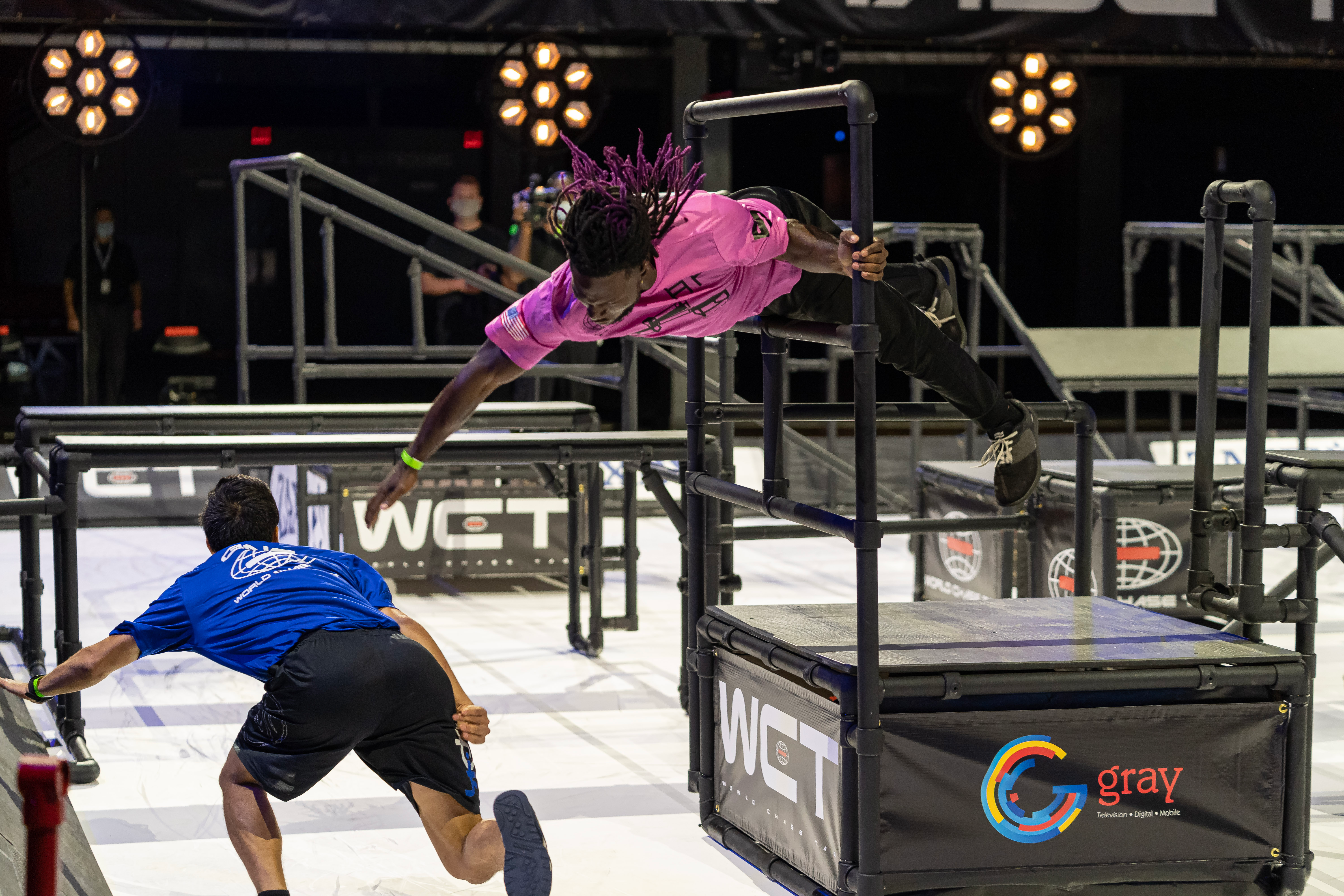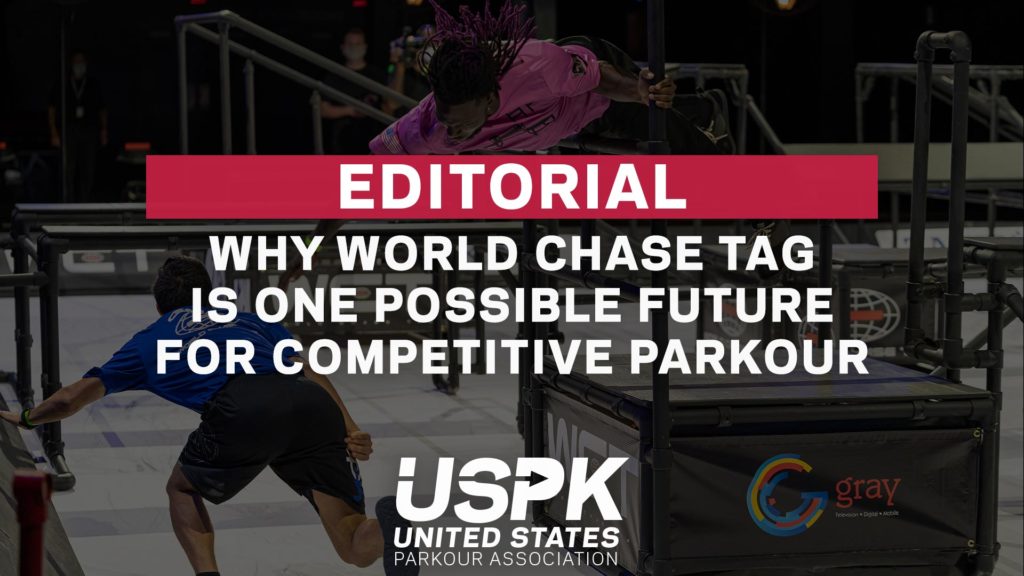
UNITED STATES PARKOUR ASSOCIATION
Why World Chase Tag is One Possible Future for Competitive Parkour
2021 JULY 31
Editorial By: Adam Kozy
Adam Kozy is the Executive Director for the United States Parkour Association, the U.S. national governing body for parkour that is dedicated to seeing the healthy growth of the sport. He also served as World Chase Tag’s head referee in 2020 and 2021 (but is under no obligation to promote or discuss the show).
With millions of views per video, World Chase Tag’s (WCT) lightning quick, adrenaline-fueled matches of traceurs chasing one another around a cube of obstacles (the Quad) has officially gone viral beyond the parkour community. YouTube, the video-sharing site that provided a platform for parkour’s rise, has even featured WCT on its own daily highlight feed. With a new USA season only one week away and a new deal inked for it to air on ESPN, its U.K. founders, the Devaux brothers, may have found a way to highlight the beauty of parkour movements and turn it into a repeatable and extremely viewable sporting format. But is it technically parkour? And what does it say about the potential competitive future of the sport?
There’s little dispute in my mind that WCT is parkour in one of its purest forms: efficiency of movement, overcoming obstacles, combining play and purposeful movement. L’art du deplacement? Competitors are literally displacing themselves through space to evade a chaser, which captures pretty much every practitioners’ fantasies about being strong to be useful. Hell, even one of the original Yamakasi members, Sebastien Foucan, has competed.
As for WCT as a competitive sport, it nails a few crucial things that other parkour competitions haven’t:
- It emphasizes efficiency of movement combined with creativity and strategy
- It highlights individual performance while still being team-based
- It’s easily repeatable without being boring
- It standardizes some parkour obstacles (the Quad)
- The audience can identify the winner without judges
- It still leaves room for athletes to experience the “flow-state”
But here’s the true beauty of tag: it needs zero explanation. Chances are every single person reading this has played tag as a child. It’s universal among cultures with different languages and customs. It’s primal in its origins, serving as both essential learning and play for children and hunting practice for early homo sapiens. And it’s still played by some of our animal cousins. I’ve personally introduced a lot of muggles (that’s non-parkour training folks) to WCT videos on YouTube and literally given them NO introduction. The reaction? Instant dopamine. They’re hooked. What started as showing some friends one video turned into two hours of watching WCT’s YouTube.
Parkour has traditionally been a bit more complicated to explain…but frankly, it shouldn’t be. Though the internal parkour community still has debates on the merits of parkour vs. freerunning, at the end of the day it’s all about either efficiency or creativity of movement. World Chase Tag shows that in spades. You may not see any of the crazy flips and insane, death-defying rooftop jumps that shot the sport to early internet virality, but make no mistake, what you see when you watch WCT is parkour with a specific purpose. The movements and agility on display are probably some of the simplest and purest to the original origins of the sport, but performed at the highest level. After graduating from backyard sessions in the U.K. to playing their new chase tag concept in parkour gyms, the Devaux’s quickly realized that the parkour athletes themselves and showcasing their unique ways of moving make for the most entertaining matches, and would be a much more relatable way for non-practitioners to watch a developing sport.
So what makes WCT different from parkour’s other forays into mainstream media? There have been plenty of attempts after all. Red Bull’s Art of Motion is a free running paradise in the world’s most picturesque locations, but not widely distributed outside Red Bull’s media empire and has received criticism for its gymnastics-like judging system. American Ninja Warrior waters true parkour athletes down with cushy obstacles that would never exist outdoors and combines it with tedious reality TV drama. Fox’s Ultimate Tag was an American Gladiator vs. Average Joes gameshow that blatantly ripped-off of WCT’s already well-known tagline “don’t get caught” (which they got caught for).
WCT has a winning combination of simplicity, a short attention span, and classic nostalgia. One chaser, one evader, 20 seconds to make a tag, and points are only given for an evasion. That’s it. Simple. And probably most importantly, easily repeatable for quick turnarounds. In an age inundated by less-than-a-minute viral TikTok and Instagram videos, WCT’s bite-sized 20 second-long matches are practically made for a generation no longer interested in long-form sports with lengthy advertisements. (For comparison, an NFL game lasts 3.5 hours but the actual action is only an hour).
Of some importance too is its broad appeal beyond the typical demographic; that includes an easily accessible format for young kids hoping to learn parkour basics, and some standardization around obstacles without limiting creativity.
Another amazing, unintended consequence of WCT is it demonstrates the unrivaled sportsmanship and camaraderie shared by parkour athletes; something frequently lauded in the (normally dreadful) comment section of YouTube. Spectators can’t help but notice the helping hand up, hug, or fist bump seconds after an intense chase and remark how it’s clear the players love what they’re doing. While new to the larger public, this phenomenon is no stranger to true traceurs and this attitude of mutual respect permeates a culture that frequently vagabonds from country to country, crashing on complete strangers’ couches. Though parkour is by its nature a solo sport (you can’t force someone to do a jump they’re not ready for), there’s a shared sense of communal pride when you conquer a challenging gap, learn a new acrobatic movement, and generally overcome personal fears and barriers…because everyone’s been there and respects you for conquering it, no matter your level.
But by far, one of the most impressive things about World Chase Tag was that, for once, I witnessed traceur/traceuses being treated like real athletes. Parkour isn’t a gimmick of the show…it IS the show. By way of comparison, I competed on one of the earlier seasons of American Ninja Warrior and arrived on set at 6pm to find: no waiting area for contestants, no water, no food, no call for warm-up, and sat around in the dark with other contestants for hours like cattle waiting for my turn to run which didn’t actually happen until 4:30am, by which point I could barely keep my eyes open, much less run a course. So it was truly a sight to behold when WCT and the Devaux brothers provided a substantially different environment for WCT 2020 and most importantly, the athletes were treated with respect. I’m not sure even the Devaux brothers were ready for how much that meant to the athletes, who regularly showered them with fist-bumps, hugs, and eventually champagne when filming concluded.
At this point, parkour has a storied history of literally everything from Hollywood, to video games, to the International Federation of Gymnastics (FIG) attempting to appropriate the sport in its infancy. Whereas skateboarding had over 20+ years to develop into a cultural and sporting phenomenon, parkour has already been bastardized for TV and sold to the Olympics by FIG before there are even bonafide competition formats. Yet it is ubiquitous in entertainment; parkour is in nearly every Marvel movie you see, every Assassin’s Creed game you play, and every commercial out there with a brand trying to look cool and edgy. But only a handful of traceurs actually can make a full-time living doing the sport they love. WCT and more competitions like it may be one of the avenues to finally broaden those opportunities.
Is World Chase Tag the perfect parkour event? Of course not, there’s always room for improvement. It’s not even officially billed as a parkour event, and the Devaux’s will tell you that ultimately they want to see the best people chase whether they’re traceurs or not. There’s a lot of things we at USPK hope to see in the future: pay for athletes, encouraging more female participation, more prize money, better high definition slo-mo, etc. But with a repeatable, safe, and short-form format that’s addicting to watch, it’s easily a top contender for how professional parkour competitions could be modeled in the future. That combination is something parkour organizations and the community at large would do well to pay attention to. Armed with wider TV exposure and the mutual respect of the parkour community, World Chase Tag has netted itself an exponentially growing following that, like its competitors, shows no signs of slowing down. USPK is excited to be working directly with WCT for its current and future U.S. events.
Catch World Chase Tag’s next U.S. event on August 6th, 2021 at 7pm Eastern on ESPN2.
WCT Schedule: https://wct.webflow.io/post/nbc-sports-network-programming-schedule

